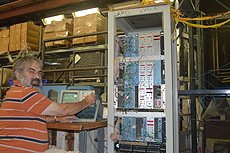PREP: Keeping experiments well equipped since 1970
 |
| Fermilab scientist Alan Hahn tests the trigger for the LBNE 35-ton prototype built using PREP equipment at PC4. Photo: Jonathan Lewis, PPD |
Back in the day, if Fermilab scientists needed equipment for an experiment, they'd go to the Physics Research Equipment Pool. PREP was created more than 40 years ago as the backbone of equipment-sharing for scientists, providing electronics for data acquisition in a long series of experiments at Fermilab.
Today, PREP still plays a strong support role in supplying researchers with equipment they need to successfully test and run experiments. While most of the equipment is used here at Fermilab, many U.S. universities, as well as other U.S. labs and a few foreign institutions, also request items from PREP's stash of goodies.
"When somebody needs to set up a test stand, the first stop is often PREP," said PPD's Jonathan Lewis, acting PREP manager. "While most of our stock is legacy equipment, we still provide equipment crucial to many experiments — crates, amplifiers, logic modules, digitizers and high-voltage supplies."
Remarkably, PREP is free, and it runs on the honor system. The PREP manager approves reasonable requests for equipment use on the Fermilab site. Requests for equipment by outside labs and universities are subject to approval by the Property Office or Fermi Site Office. Once returned, PREP staff test equipment for function and place it in the ready-to-issue area. About seven people maintain PREP. Lewis encourages users to return equipment as soon as they are done with it.
"Popular modules like the LeCroy 222 seem to fly of the shelf as soon as we put them out," he said, referring to a device crucial for timing electronic signals.
The PREP group is remodeling the program with the future in mind.
"We're trying to reorganize to best serve the needs of the neutrino and muon programs, as well as detector R&D," Lewis said. "In the past year we've revamped our procedures, added a full-time repair technician and built a new user-friendly website."
PREP has its sights set on acquiring more up-to-date technology to benefit Fermilab and borrowing universities.
Lewis hopes that PREP's potential new electronics will reflect the technology that scientists are using for these types of programs.
Bob Tschirhart, scientist in the Scientific Computing Division, recently used PREP's equipment for test beams.
"The equipment PREP has is quite useful, but I've been interested in getting more modern equipment in there," he said.
"Our goal is simple," said Lewis. "We aim to back experiments and provide them the electronics support that they need."
—Hanae Armitage
|